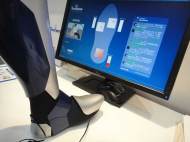ShokacCube – soft and flexible touch sensor capable to detect changes in 3D
 Unlike other touch sensors we previously wrote about, a University of Tokyo spin-off company Touchence has designed ShokacCube – the world’s first soft and flexible touch sensor capable to detect changes in 3D. The technology could aid in robotics and present a major breakthrough in bionics where it could be used for better feedback and control of artificial limbs.
Unlike other touch sensors we previously wrote about, a University of Tokyo spin-off company Touchence has designed ShokacCube – the world’s first soft and flexible touch sensor capable to detect changes in 3D. The technology could aid in robotics and present a major breakthrough in bionics where it could be used for better feedback and control of artificial limbs.
It was initially developed in cooperation between Satake Precision Technology (SPT) and University of Tokyo in December 2010, in order to create a more natural touch sensor for robots. By April 2011, they have tweaked the technology to become more power efficient and durable, and decided to create the spin-off company and place their product on the market as a tactile sensor.
The soft and flexible part of the sensor is made of Polyurethane foam and it uses optical sensors to detect changes in three dimensions. There are five light sensors on top which detect the intensity of the light which enters from the bottom. The amount of light reaching each receiver during contact represents the data used to detect the location and pressure of the touched area.
Since the sensor is soft and able to change shape, it can recognize different types of touch interaction with high sensitivity. The technology is able to detected minute changes and recognizes shear stress movement. Since it is three dimensional, it is also capable to detect when it is pinched, pushed or stroked.
“When a robot touches a human, most people aren’t going to enjoy a hard, metallic touch. So in the future, robots are likely to have soft coverings. But even with a soft exterior, if there’s something hard underneath it, that will feel strange. So it’s necessary to put soft sensors underneath soft coverings. One application for this is detecting touch with a soft covering, so that when a robot actually touches you, it doesn’t feel like there’s a sensor underneath”, said Naoya Maruyama, Vice President of Touchense.
The number of sensors per area on the exterior can be minimized because of less non-sensing area of ShokacCube. You can also connect an array of 9 sensors per controller board by using SMBus.
Aside the use in robotics and bionics, the technology could be used in robotic pets, or as a game controller. The sensor can be embedded into a car seat, medical bed or massage chair where it could sense positions or motions of a user without comfort spoiling. By utilizing MEMS technology, they adapted the technology for mass production. This enhanced version of their sensor will be available from September 2011, and its price hasn’t been announced yet.









Leave your response!